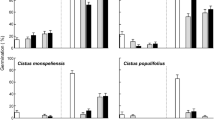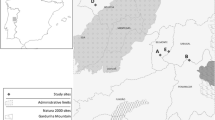Abstract
Background and aims
Understanding the mechanistic effects of climate change on species key life-history stages is essential for predicting ecological responses. In fire-prone regions, long-term seed banks allow post-fire recovery and persistence of plant populations. For physically dormant species, seed bank longevity depends on the maintenance of dormancy which is controlled primarily by temperature. Successful inter-fire recruitment is rare and dormancy loss between fires produces a net loss to the seed bank. We assessed whether temperature increases related to climate change can affect seed dormancy and, potentially, seed bank longevity.
Methods
We quantified the relationship between air temperatures and soil temperatures. Seeds of two shrub species, from four populations along an altitudinal gradient, were then exposed to a range of soil temperatures calculated to occur at the end of the 21st century, using projected mean and heat wave scenarios. Alterations to dormancy were assessed via germination.
Results
For every 1°C increase in air temperature, associated soil temperature increased by 1.5°C. Mean temperature increase had no affect on seed dormancy. However, future heat wave conditions produced soil temperatures that significantly increased dormancy loss. This impact was greatest in seeds from cooler, high elevation populations.
Conclusions
Projected heat wave events produce conditions that provide a mechanism for seed bank compromise. Dormancy-breaking temperatures for each population were positively related to parental environment temperatures, indicating local adaptation. Whilst heat from fire may govern post-fire recruitment response, we suggest that parental climate is the key selective force determining dormancy-breaking threshold temperatures, ensuring inter-fire seed bank persistence.



Similar content being viewed by others
References
Alexander LV, Arblaster JM (2009) Assessing trends in observed and modelled climate extremes over Australia in relation to future projections. Int J Climatol 29:417–435
Auld TD (1986a) Population dynamics of the shrub Acacia suaveolens (Sm.) Willd.: fire and the transition to seedlings. Aust J Ecol 11:373–385
Auld TD (1986b) Population dynamics of the shrub Acacia suaveolens (Sm.) Willd.: dispersal and the dynamics of the soil seed bank. Aust J Ecol 11:235–254
Auld TD (1996) Ecology of the Fabaceae in the Sydney region: fire, ants and the soil seed bank. Cunninghamia 4:531–551
Auld TD, Bradstock RA (1996) Do post-fire soil temperatures influence seed germination? Aust J Ecol 21:106–109
Auld TD, O’Connell MA (1991) Predicting patterns of post-fire seed germination in 35 eastern Australian Fabaceae. Aust J Ecol 16:53–70
Auld TD, Keith DA, Bradstock RA (2000) Patterns in longevity of soil seedbanks in fire-prone communities of south-eastern Australia. Aust J Bot 48:539–548
Baeza MJ, Roy J (2008) Germination of an obligate seeder (Ulex parviflorus) and consequences for wildfire management. Forest Ecol Manag 256:685–693
Baskin CC, Baskin JM (1998) Seeds: ecology, biogeography, and evolution of dormancy and germination. Academic, San Diego
BOM (2011) An exceptional summer heat wave in greater Sydney and the Hunter Valley. Special Climate Statement 27, Bureau of Meteorology NSW Climate Services Centre
Christensen JH, Hewitson B, Busuioc A, Chen A, Gao X, Held I, Jones R, Kolli RK et al (2007) Regional climate projections. In: Solomon S, Qin D, Manning M, Chen Z, Marquis M, Averyt KB, Tignor M, Miller HL (eds) Climate change 2007: The physical science basis. Contribution of working group I to the fourth assessment report of the intergovernmental panel on climate change. Cambridge University Press, Cambridge
CSIRO (2007) Climate change in Australia: technical report 2007. CSIRO, Australia
de Boeck HJ, Dreesen FE, Janssens IA, Nijs I (2010) Climatic characteristics of heat waves and their simulation in plant experiments. Global Change Biol 16:1992–2000
Dorne AJ (1981) Variation in seed germination inhibition of Chenopodium bonus-henricus in relation to altitude of plant growth. Can J Bot 59:1893–1901
Fenner M, Thompson K (2005) The ecology of seeds. Cambridge University Press, Cambridge
Figueroa R, Herms DA, Cardina J, Doohan D (2010) Maternal environment effects on common groundsel (Senecio vulgaris) seed dormancy. Weed Sci 58:160–166
Fukami T, Wardle DA (2005) Long-term ecological dynamics: reciprocal insights from natural and anthropogenic gradients. P Roy Soc Lon B Bio 272:2105–2115
Grime JP (1989) Seed banks in ecological perspective. In: Leck MA, Parker VT, Simpson RL (eds) Ecology of soil seed banks. Academic, San Diego, pp 15–22
Gutterman Y (2000) Maternal effects on seeds during development. In: Fenner M (ed) Seeds: the ecology of regeneration in plant communities. CABI, Wallingford, pp 59–84
Gutterman Y, Gozlan S (1998) Amounts of winter or summer rain triggering germination and ‘the point of no return’ of seedling desiccation tolerance, of some Hordeum spontaneum local ecotypes in Israel. Plant Soil 204:223–234
Harper JL (1977) Population biology of plants. Academic, London
Harte J, Torn MS, Chang F, Feifarek B, Kinzig AP, Shaw R, Shen K (1995) Global warming and soil microclimate: results from a meadow-warming experiment. Ecol Appl 5:132–150
Hille Ris Lambers J, Harpole WS, Schnitzer S, Tilman D, Reich PB (2009) CO2, nitrogen and diversity differentially affect seed production of prairie plants. Ecology 90:1810–1820
Holmes PM, Newton RJ (2004) Patterns of persistence in South African fynbos. Plant Ecol 172:143–158
Hoyle GL, Steadman KJ, Daws MI, Adkins SW (2008) Pre- and post-harvest influences on seed dormancy status of an Australian Goodeniaceae species, Goodenia fasicularis. Ann Bot-London 102:93–101
IPCC (2007) Climate change 2007 synthesis report. An assessment of the Intergovernmental Panel on Climate Change, Geneva
Keeley JE (1987) Role of fire in seed germination of woody taxa in California chaparral. Ecology 68:434–443
Lacerda DR, Filho JPL, Goulart MF, Ribeiro RA, Lovato MB (2004) Seed dormancy variation in natural populations of two tropical leguminous tree species: Senna multijuga (Caesalpinoideae) and Plathymenia reticulata (Mimosoideae). Seed Sci Res 14:127–135
Lamont BB, le Maitre DC, Cowling RM, Enright NJ (1991) Canopy seed storage in woody plants. Bot Rev 57:277–317
Marthews TR, Mullins CE, Dalling JW, Burslem DFRP (2008) Burial and secondary seed dispersal of small seeds in a tropical forest. J Trop Ecol 24:595–605
Martin RE, Miller RL, Cushwa CT (1975) Germination response of legume seeds subjected to moist and dry heat. Ecology 56:1441–1445
Meney KA, Nielssen GM, Dixon KW (1994) Seed bank patterns in Restionaceae and Epacridaceae after wildfire in kwongan in southwestern Australia. J Veg Sci 5:5–12
Michael PJ, Steadman KJ, Plummer JA (2006) Climatic regulation of seed dormancy anf emergence of diverse Malva parviflora populations from a Mediterannean-type environment. Seed Sci Res 16:273–281
Mott JJ (1972) Germination studies on some annual species from an arid region of Western Australia. J Ecol 60:293–304
Mpelasoka F, Hennessy K, Jones R, Bates B (2008) Comparison of suitable drought indices for climate change impacts assessment over Australia towards resource management. Int J Climatol 28:1283–1292
Ooi MKJ (2007) Dormancy classification and potential dormancy-breaking cues for shrub species from fire-prone south-eastern Australia. In: Adkins SW, Ashmore S, Navie SC (eds) Seeds: biology, development and ecology. CABI, Wallingford, pp 205–216
Ooi MKJ, Auld TD, Whelan RJ (2004) Comparison of the cut and tetrazolium tests for assessing seed viability: a study using Australian native Leucopogon species. Ecol Manag Restor 5:141–143
Ooi MKJ, Auld TD, Whelan RJ (2007) Distinguishing between persistence and dormancy in soil seed banks of three shrub species from fire-prone south-eastern Australia. J Veg Sci 18:405–412
Ooi MKJ, Auld TD, Denham AJ (2009) Climate change and bet-hedging: interactions between increased soil temperatures and seed bank persistence. Global Change Biol 15:2375–2386
Orscheg CK, Enright NJ (2011) Patterns of seed longevity and dormancy in obligate seeding legumes of box-ironbark forests, south-eastern Australia. Austral Ecol 36:185–194
Pausas JG, Bradstock RA, Keith DA, Keeley JE, The GCTE (Global Change of Terrestrial Ecosystems) Fire Network (2004) Plant functional traits in relation to fire in crown-fire ecosystems. Ecology 85:1085–1100
Perkins SE, Pitman AJ, Sisson SA (2009) Smaller projected increases in 20-year temperature returns over Australia in skill-selected climate models. Geophys Res Lett 36:L06710
Petrů M, Tielbörger K (2008) Germination behaviour of annual plants under changing climatic conditions: separating local and regional environmental effects. Oecologia 155:717–728
Prentice IC, Cramer W, Harrison LR, Monserud RA, Soloman AM (1992) A global biome model based on plant physiology and dominance, soil properties and climate. J Biogeog 19:117–134
R Development Core Team (2010) R: A Language and Environment for Statistical Computing. R Foundation for Statistical Computing, Vienna, Austria. url: http://www.R-project.org
Raison RJ, Woods PV, Jakobsen BF, Bary GAV (1986) Soil temperatures during and following low-intensity prescribed burning in a Eucalyptus pauciflora forest. Aust J Soil Res 24:33–47
Royer PD, Cobb NS, Clifford MJ, Huang C-Y, Breshears DD, Adams HD, Camilo Villegas J (2011) Extreme climatic event-triggered overstorey vegetation loss increases understorey solar input regionally: primary and secondary ecological implications. J Ecol 99:714–723
Santana VM, Bradstock RA, Ooi MKJ, Denham AJ, Auld TD, Baeza MJ (2010) Effects of soil temperature regimes after fire on seed dormancy and germination in six Australian Fabaceae species. Aust J Bot 58:539–545
Skelly DK, Joseph LN, Possingham HP, Freidenburg LK, Farrugia TJ, Kinnison MT, Hendry AP (2007) Evolutionary responses to climate change. Cons Biol 21:1353–1355
Thürig B, Körner C, Stöcklin J (2003) Seed production and seed quality in a calcareous grassland in elevated CO2. Global Change Biol 9:873–884
Tieu A, Dixon KW, Meney KA, Sivasithamparam K (2001) The interaction of heat and smoke in the release of seed dormancy in seven species from southwestern Western Australia. Ann Bot-London 88:259–265
Tryhorn L, Risbey J (2006) On the distribution of heat waves over the Australian region. Aust Met Mag 55:169–182
Walck JL, Hidayati SN, Dixon KW, Thompson K, Poschlod P (2011) Climate change and plant regeneration from seed. Global Change Biol 17:2145–2161
Whelan RJ (1995) The ecology of fire. Cambridge University Press, London
Woodward FI (1987) Climate and plant distribution. Cambridge University Press, Cambridge
Acknowledgements
MO received financial assistance to conduct this study from a Knowledge Transfer Project Fund and additional funds provided under a collaborative agreement between the Department of Environment, Climate Change and Water NSW (Australia) and The University of Sheffield (UK).
Author information
Authors and Affiliations
Corresponding author
Additional information
Responsible Editor: Jeffrey Walck.
Rights and permissions
About this article
Cite this article
Ooi, M.K.J., Auld, T.D. & Denham, A.J. Projected soil temperature increase and seed dormancy response along an altitudinal gradient: implications for seed bank persistence under climate change. Plant Soil 353, 289–303 (2012). https://doi.org/10.1007/s11104-011-1032-3
Received:
Accepted:
Published:
Issue Date:
DOI: https://doi.org/10.1007/s11104-011-1032-3




